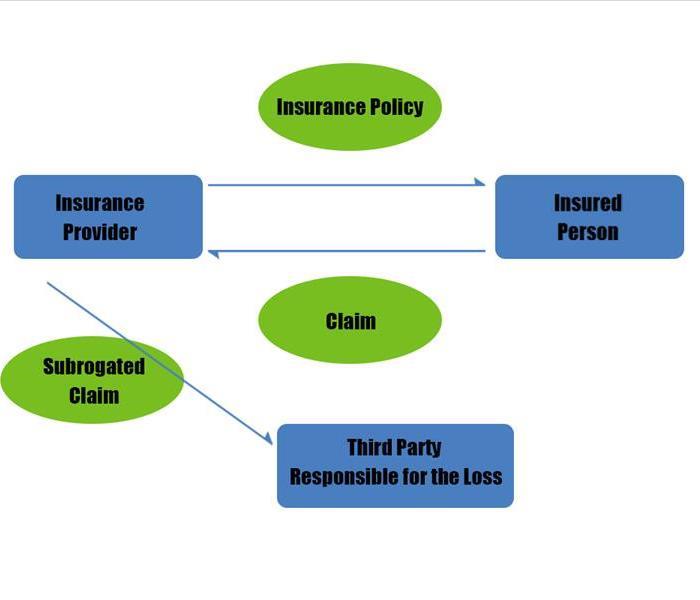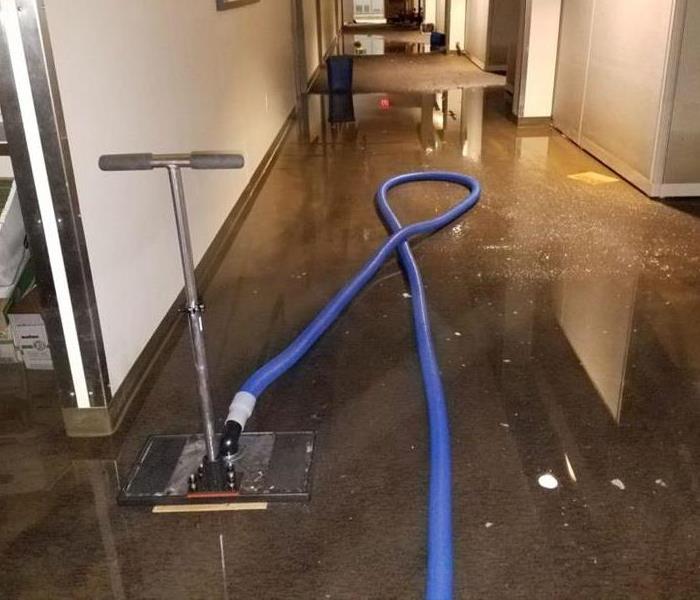Recent Posts
Understanding the Scope of Insurance Coverage for Water Damage
8/30/2023 (Permalink)
 A restoration crew dealing with water damage
A restoration crew dealing with water damage
Water damage is a homeowner's nightmare that can strike unexpectedly, wreaking havoc on properties and belongings. Fortunately, homeowners' insurance can provide a lifeline of financial protection in these trying times. In this blog post, we'll dive into the essential aspects of homeowners' insurance coverage for water damage, ensuring you're well-equipped to safeguard your home and assets.
1. Burst Pipes and Plumbing Failures:
A burst pipe or plumbing failure can lead to extensive water damage. Homeowners' insurance typically covers the cost of repairing the damage caused by such incidents. This can include structural repairs, replacing damaged flooring, and restoring affected belongings.
2. Storm-Related Water Intrusion:
Damage from storms, hurricanes, and heavy rainfall often leads to water intrusion. Homeowners' insurance generally covers the damage caused by these natural events, including water-soaked walls, ceilings, and possessions.
3. Appliance Malfunctions:
Malfunctions in household appliances like washing machines, dishwashers, and water heaters can result in leaks and flooding. Homeowners' insurance often extends coverage to address the water damage resulting from these situations.
4. Roof Leaks:
A damaged roof can permit water to seep into your home, causing significant interior damage. Homeowners' insurance typically covers repairs to your roof and the damage caused by leaks.
5. Sewer and Drain Backup:
Sewer or drain backups can lead to water damage that's not only unpleasant but also hazardous. Many homeowners' insurance policies include coverage for the cleanup and repairs associated with sewer and drain backup incidents.
6. Floods and Water Intrusion:
It's important to note that standard homeowners' insurance usually does not cover flooding. For protection against flood-related water damage, a separate flood insurance policy is necessary, often provided through the National Flood Insurance Program (NFIP).
7. Mitigation Costs:
Homeowners' insurance also commonly covers the costs of mitigating water damage, such as hiring professionals to dry out the affected areas and prevent mold growth.
8. Limits and Deductibles:
It's crucial to understand the limits and deductibles of your homeowners' insurance policy. Review your policy carefully to ensure that your coverage aligns with your needs and potential risks.
In conclusion, homeowners' insurance plays a vital role in mitigating the financial impact of water damage. However, understanding the scope of coverage is essential to avoid surprises when filing a claim. Regularly reviewing and updating your policy can ensure you're adequately protected against the unexpected. Remember, safeguarding your home against water damage is not just about protecting your investment—it's about securing your peace of mind.
Overlooked Post-Fire Hazards: Smoke and Soot
8/23/2023 (Permalink)
 A picture of fire
A picture of fire
In the wake of the recent wildfire outbreak in Kelowna, British Columbia, attention is rightly directed towards the immediate destruction caused by the flames. However, it's crucial not to overlook the less visible yet equally damaging aftermath – the effects of smoke and soot. As the fires are extinguished, the arduous process of post-fire recovery and restoration begins. While most focus on the areas directly impacted by the flames, it's important to recognize that even structures untouched by the fire itself may require specialized attention due to smoke and soot infiltration.
The hazards of smoke and soot are not to be underestimated:
Health Implications: Smoke contains a myriad of harmful particles and chemicals that can linger in the air and seep into buildings. Prolonged exposure can result in respiratory problems, exacerbating existing conditions or causing new ones.
Structural Damage: Smoke and soot can corrode various materials, such as metal and glass, and even lead to discoloration, staining, and foul odors. Left unchecked, these damages can worsen over time.
Air Quality: Even after the fire is out, lingering smoke particles can contribute to poor indoor air quality. This can be particularly concerning for individuals with respiratory sensitivities.
Cleanup Challenges: Properly removing smoke and soot residues requires specialized cleaning techniques. Incorrect methods might exacerbate the issue or cause further damage.
Insurance Complexities: Insurance claims for smoke and soot damage can be intricate and may necessitate documentation and professional assessments to ensure fair coverage.
Long-Term Impact: Overlooking the effects of smoke and soot can lead to ongoing issues that might compromise the safety and habitability of a structure.
In the aftermath of a wildfire, it's essential to engage experts who can assess and mitigate the effects of smoke and soot. Restoration specialists, such as SERVPRO, a professional restoration and cleaning company, can ensure that buildings are safe to occupy and free from hidden hazards. By recognizing these often neglected consequences of wildfires, we can foster a more comprehensive approach to disaster recovery that truly supports affected communities. Remember, SERVPRO is ready to serve you anytime.
Attic Attack
8/23/2023 (Permalink)
 A man doing attic attack
A man doing attic attack
Addressing mold issues in moldy attics, crawlspaces, and confined spaces poses a significant challenge. Collaborating with industry pioneers, we have adopted an innovative strategy – the "Concrobium- Attic Attack" method – to effectively tackle these problematic zones.
Traditional approaches to remediating attics and crawlspaces involve labor-intensive and costly procedures such as sanding, scrubbing, brushing, or blasting. These methods not only demand substantial time and effort but also impact the overall profitability of the project.
Enter Attic Attack! – a groundbreaking alternative that aligns seamlessly with the established Standard of Care while delivering a range of advantages over the conventional techniques:
Elimination of Sanding, Brushing, or Blasting: Our method removes the need for these time-consuming and abrasive procedures.
No Requirement for Expensive Equipment: Attic Attack! doesn't rely on cumbersome machinery, reducing costs and complexities.
Avoidance of Hazardous Chemicals: Our approach prioritizes safety by eschewing the use of harmful substances.
Reduced Time, Labor, and Liability: Attic Attack! streamlines the process, minimizing labor requirements and associated risks.
Cost-Efficiency: By sidestepping labor-intensive methods, our approach slashes costs significantly.
At the core of Attic Attack! lie two pioneering technologies:
Concrobium Mold Stain Remover: A revolutionary solution that eliminates mold staining without the need for scrubbing or toxic chemicals.
Concrobium Mold Control: A zero-VOC antimicrobial agent that not only remediates mold spores but also prevents their reappearance.
The Attic Attack! procedure is straightforward and aligns seamlessly with established industry protocols. After isolation and controlled ventilation, restoration experts employ Concrobium Mold Stain Remover (followed by HEPA vacuuming) to erase mold staining and physically detach mold from the substrate. As a concluding step, Concrobium Mold Control is dispersed in a fine mist to ensure the treated area is ready for post-remediation verification.
The results are nothing short of remarkable. Supported by an independent study, it has been scientifically demonstrated that Concrobium Mold Stain Remover surpasses the effectiveness of sanding techniques, all while drastically reducing labor costs.
What to do when your basement floods?
8/23/2023 (Permalink)
 Flooded Basement
Flooded Basement
Start with these steps:
- Shut off electricity and gas in the area. If you’re not sure how, call an electrician or SERVPRO, who can get someone out to you right away.
- Try to determine the source of the water. Excessive rainfall or a burst pipe are two top reasons why your basement may flood.
- If safe to proceed, while wearing protective gear like boots, gloves, and a mask, enter the water to investigate the source further. If your basement has a drain and you can safely navigate to it, check to see if it is clogged.
- Time to get that water out of there. Depending on the amount of water, this may be as simple as using towels, a mop, or a wet vacuum. If the flooding is more extensive, a sump pump is necessary. Once the bulk of the water has been removed, soak up all remaining moisture with towels.
- Assess damage. Remove any items, like furniture, that appear damaged by the water and move them to a space where they can dry. If the drying process on items is taking longer than a couple of days, unfortunately, they may not be able to be salvaged. Any items that were within boxes should be removed to air out, and all items should be monitored for mildew growth.
- Get the air moving in the basement to dry it out. Open windows and doors, and use fans placed around the space to inspire quick drying of the flooded area. If you have a dehumidifier, move it to the basement to aid the drying process.
How to prevent your basement from flooding?
It’s easy to look back at the cause of a flooded basement and see where things went wrong, but what about preventing flooding before it occurs? There are some measures you can take today to help waterproof your basement and safeguard it against a catastrophic flooding episode.
- Keep your rain gutters clean, and make sure they’re pointed away from the foundation of your home.
- During the next heavy rain, check around your yard to see where water is pooling and being diverted. If it’s going toward the foundation of your home, contact an expert to grade your yard so it’s able to properly handle the water it receives during storms.
- If you have a basement window, make sure it’s protected with a window well cover.
- A sump pump can be your basement’s savior. An automatic sump pump set to trigger when it senses water in your basement space offers a layer of protection for your home, even when you’re not there. Homeowners in particularly flood-prone areas should have a backup sump pump, and check to see if flood insurance is available for purchase.
When to call for help with basement flooding:
Calling a professional for help with a flooded basement is always a good idea, especially if the amount of water is more than a foot deep, many items have become wet, or mildew is beginning to take hold. Quickly removing the water and beginning the drying process is essential to lessen the possibility of mold forming, which can greatly increase the damage and cost involved.
We have the experience, qualifications, and knowledge needed to help you quickly deal with a flooded basement cleanup because we handle these types of jobs all the time. Let us deal with the stress and get your basement back in working order.
Give us a call at 1-800-SERVPRO or 604-746-4666 near you to get help with your water cleanup. We’ll take the worry for you.
What is homeowners insurance subrogation?
3/4/2021 (Permalink)
 How Subrogation Work
How Subrogation Work
Subrogation, the substitution of one's rights to another, enables the insurance company to make a claim against the manufacturer or installer of the furnace to recover the money the insurance company paid to re-build your house.”
Imagine opening the door to your condominium (“condo”) only to be confronted by several inches of standing water. The first call is to your insurance company, which must then consider not only mitigating, adjusting and paying the claim, but subrogating against those responsible for the loss. Determining who is liable for such damage can be tricky and it depends on the source of the water. Condo associations carry insurance to cover common areas while individual condo owners carry coverage covering the interiors of their units, including the walls, flooring, and contents. A toilet supply line may have failed. The bathtub may have been left running in the unit above. Faulty construction or renovations may have allowed rain to infiltrate and cause damage. A washing machine next door may have failed. Regardless the cause, however, an even bigger obstacle may be overcoming state law and certain declarations intended to bar one unit owner (or his/her insurance carrier) from suing/subrogating against another unit owner. Knowing the law in this area from state to state becomes critical in evaluating subrogation potential.
Extraction: Remove the Easy Water First
3/4/2021 (Permalink)
 weight assist extraction tool extract standing water
weight assist extraction tool extract standing water
The most effective way to speed the drying process for a water loss is to remove as much of the water in liquid state as possible during the extraction phase. Poor extraction will significantly slow the drying process.
At SERVPRO of Abbotsford we use professional industrial-grade water extraction machines as well as weight assist extraction tools to remove the most portion of the water from the loss site.
Concrobium: Attic Attack
3/2/2021 (Permalink)
Moldy attics, crawlspaces and other confined areas are especially challenging to remediate. Working with industry leaders, we utilize a new methodology - "Concrobium- Attic Attack" to target these tough spaces!
Current remediation approaches in attics and crawlspaces involve sanding, scrubbing, brushing or blasting – labor-intenstive, expensive techniques that bite into job profitability.
Attic Attack! offers a new approach that is totally consistent with the Standard of Care and offers distinct advantage compared with the ‘old’ way of doing things:
- NO sanding, brushing or blasting
- NO expensive, cumbersome equipment
- NO hazardous chemicals
- LESS Time, Labor, and Liability
- LESS Costs
At the heart of Attic Attack! are two innovative technologies:
Concrobium Mold Stain Remover, a revolutionary solution that removes mold staining with no scrubbing and no toxic chemicals.
Concrobium Mold Control, a unique, zero-VOC antimicrobial that remediates mold spores and prevents the recurrence of mold.
The Attic Attack! the process is simple and completely consistent with established industry protocols. Following isolation and air exchange, restoration contractors use Concrobium Mold Stain Remover (plus HEPA vacuuming) to remove mold staining and physically separate mold from the substrate. As a final step, Concrobium Mold Control is fogged to ensure the target area is ready for post-remediation verification.
The results are incredible. And they’re scientifically backed up by a third-party study demonstrating that Concrobium Mold Stain Remover is more effective than sanding techniques, at a fraction of the labor cost.
Prevent Frozen Pipes During Extreme Weather Condition
3/2/2021 (Permalink)
The best prevention against frozen pipes is to keep them warm enough to stay above the freezing point. You can do this with any one of six simple steps or, better still, a combination of measures. It is a common misconception that frozen pipes are an issue only for homes in typically cold climates.
Tip #1: Keep the Heat On
If you or your tenants are leaving for a long period of time, make sure that the heat is kept on in your property. It may be difficult to convince your tenants to leave their heat on when they are away, especially if they are responsible for paying their own utility bills. You should inform them that the heat can help prevent pipes from freezing, and if pipes freeze and burst, it can cause a lot of water damage to the property and to their possessions.
The heat does not have to be kept as high as you normally would keep it if you were actually in the property, but keeping it set above 50 F is a good idea. This should provide enough heat to keep the pipes warm and to prevent any water inside from freezing.
Tip #2: Allow the Faucet to Drip
If you are afraid a pipe will freeze, you can open the faucet fed by that pipe just a bit so the faucet drips slightly. Allowing the faucet to be open like this relieves pressure in the system. If a pipe freezes, it is actually the pressure that is created between the blockage and the faucet that will cause the pipe to burst. Allowing the faucet to be open will prevent this pressure from building up and thus keep the pipe from bursting. If the faucet is served by both hot and cold water pipes, open both faucet taps slightly, or set a single-handle faucet (such as a kitchen faucet) to warm.
Tip #3: Keep Interior Doors Open
Pipes are often located in cabinets. When the temperature drops, it is a good idea to keep these cabinet doors open so that the heat from the rest of the house can keep the pipes warm as well. You should also keep all interior doors open so that the heat can flow throughout the home.
Tip #4: Seal up Cracks and Holes
Seal gaps around holes where pipes run through walls or floors, especially where the hole is letting in cold air. Use caulk or spray foam insulation (such as Great Stuff) to fill the gaps. If possible, seal holes on both the interior and exterior side of wall or floor. Cold outdoor air that gets in through holes and gaps can make a cabinet compartment, which is usually pretty cold, even colder.
Tip #5: Apply Heating Tape
Heating tape works like an electric blanket for pipes, supplying heat directly to the pipe to keep it warm curing cold spells. This can be a good solution for short sections of pipe that are at high risk for freezing and are easily accessible so you can install the tape and can monitor it for problems.
There are two types of heating tape. One type turns on and off by itself when it senses heat is needed. The other type must be plugged in when heat is needed and unplugged when not in use; it does not have an automatic or manual on/off switch. Much like a space heater, these products can be dangerous, so you must follow the product’s direction and safety procedures exactly.
Tip #6: Add Extra Insulation
Pipes that are located in areas that do not have proper insulation, such as basements or attics, may need extra insulation to keep from freezing. Pipes in basements or attics are not the only ones that may not be properly insulated from the cold. If you have had a problem with pipes freezing anywhere in your home, extra insulation could be the cure.
Pipes can be fitted with foam rubber or fiberglass sleeves to help decrease the chances of freezing. This can be an easy solution for pipes that are exposed but can get expensive if walls, floors, or ceilings have to be opened in order to properly insulate the pipe. Additional insulation can also be added to walls and ceilings to keep the pipes warm.
Insulation can help keep a pipe closer to the temperature of the water inside the pipe, but it does not add heat to the pipe and will not prevent freezing if the pipe is exposed to prolonged freezing temperatures.
Giving Back to the Community
3/2/2021 (Permalink)
 Hospital Activity Book
Hospital Activity Book
It is not just making money, it is about helping people and giving back to the community...
Hope the little ones happy every day.
Cleanliness is confidence: Reopen your business with Certified: SERVPRO Cleaned
9/24/2020 (Permalink)
 Certified: SERVPRO Cleaned
Certified: SERVPRO Cleaned
Today, reopening your business means committing to a higher standard of clean. SERVPRO® is equipped to give your customers, your staff and your community the confidence and security they deserve with Certified: SERVPRO Cleaned.
Join SERVPRO® Chief Marketing Officer Mike Stahl and learn how Certified: SERVPRO Cleaned can help drive a confident reopening for your business.
To get a free quote on your specialized viral pathogen cleaning program, fill out the form below.
Have Questions? Call Today 604-746-4666

 24/7 Emergency Service
24/7 Emergency Service







